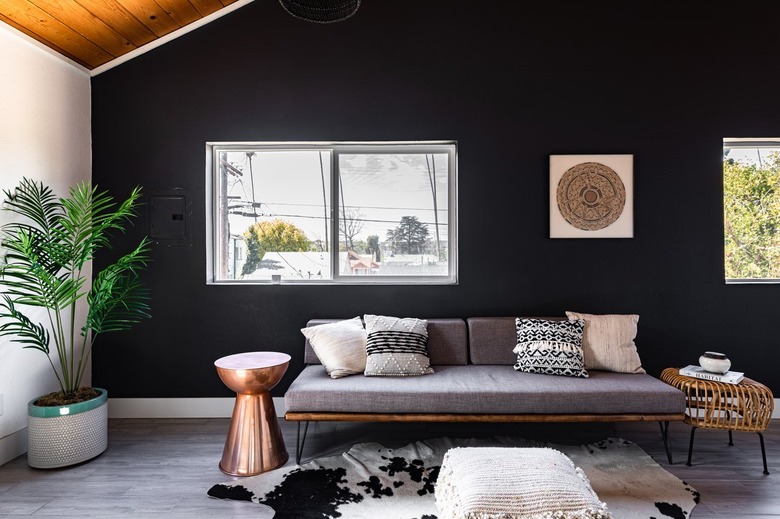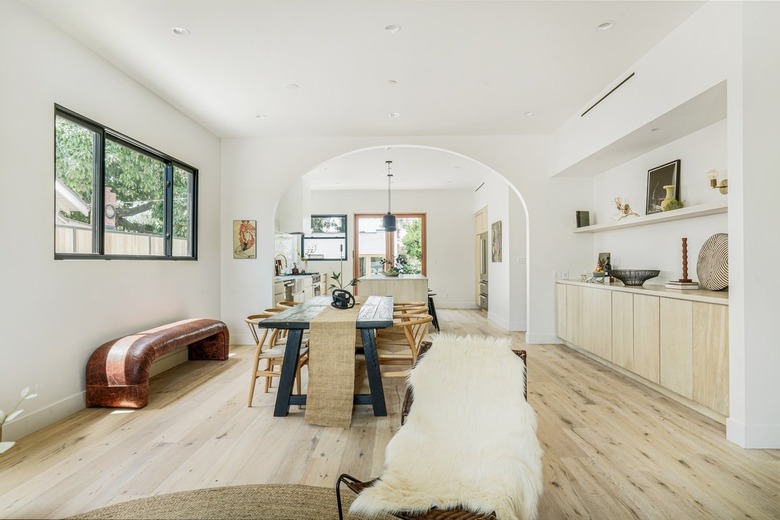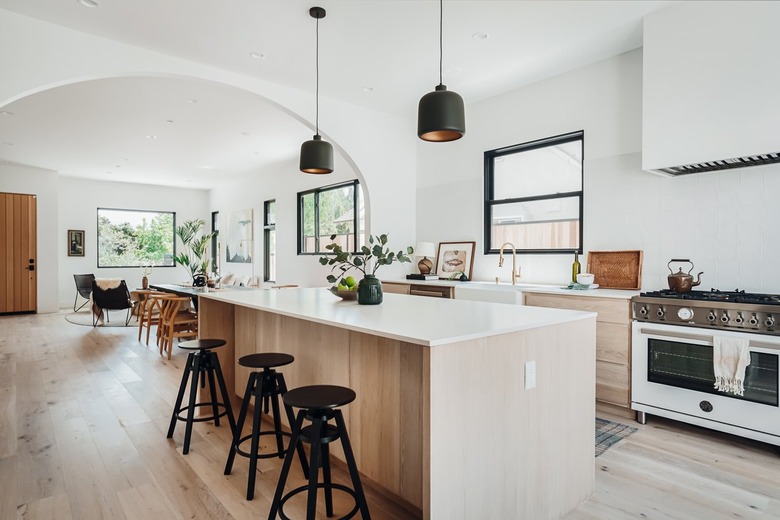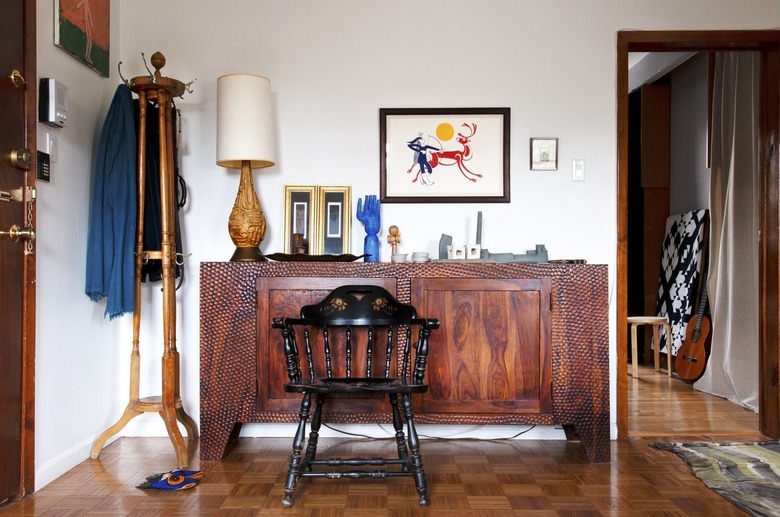Satin Vs. Semigloss Finishes: Which Is Better?
We may receive a commission on purchases made from links.
Although you might assume the toughest painting decision is choosing the color, it could actually be determining the finish, which refers to the sheen or shine of the surface after the paint dries. Paint finishes are available in flat/matte, eggshell, satin, semigloss, and high gloss — and each of these is best suited for specific projects. What many prospective painters often get stuck on, however, are the slight differences between satin and semigloss paint.
Satin and semigloss are both excellent choices for a wide variety of applications, but making the right choice between the two subtly different finishes requires learning the pros and cons of each.
Tip
Satin is one of the most popular finishes in homes because it doesn't show imperfections as much as shinier paints, but it is still long-lasting and easy to clean. Semigloss paint is slightly more durable and is water-resistant and easier to clean, but it does show flaws more than satin paint.
What Is a Satin Finish?
What Is a Satin Finish?
Satin finish offers a mildly glossy veneer that is often described as velvety because it reflects enough light to give the walls a subtle glow. Its slight matte-like qualities still allow the paint to be true to the color you selected, since it won't be dramatically affected by sheen from the light. In these aspects, it is similar to — and often confused with — eggshell paint because they both gently reflect light without appearing too shiny.
Pros
Satin paint is commonly used due to its ability to absorb light, which means it better hides imperfections while also ensuring the paint color shines through without too much distortion from reflecting light. Satin is great to use in busy areas and those that get dirtied frequently because it is more durable and easier to clean. This type of finish resists scuffs and stains, and it can hold up to certain cleaning products that may damage more matte finishes. In fact, because it hides imperfections while still holding up against damage and regular cleanings, satin is the most common interior paint finish in the United States.
Cons
On the downside, satin's slightly increased reflectiveness means it can show imperfections, like dents, lumps, or scratches, more so than matte paints (even if it shows fewer imperfections than glossier paints). It is also still shiny enough that it may distort and reduce the impact of particularly rich colors, which is why flat paint is typically preferable when you want dark shades.
Because the sheen can show more blemishes, take care when applying it in order to ensure the paint looks even and doesn't leave visible brush strokes on your walls. Careful application should prevent these problems, and the finish is easy enough to work with that you should be able to touch up the paint without issue.
It's also important to recognize that while satin is more resistant to water than more matte paints, it is still fairly susceptible to moisture and should be avoided in areas frequently exposed to water or high humidity levels.
Best Rooms to Use a Satin Finish
Best Rooms to Use a Satin Finish
Overall, family rooms, living rooms, hallways, foyers, and dining rooms are great options for satin-finish paints because these frequently used rooms do best with a durable paint. While satin finish is reasonably tough and can be cleaned fairly easily, it is not particularly suited to areas where it will be regularly exposed to moisture. For this reason, it is best avoided in bathrooms with a tub or shower (however, it's definitely okay to use in a powder room).
Satin finish may be a good choice for kitchens, but if your kitchen gets very messy, humid, or wet, opt for something glossier. Similarly, while many homeowners use satin finish in their bedrooms, if you want a rich, dark hue, you may want something more matte. Alternatively, for children's rooms that are likely to get covered in markers, crayons, or grime, a glossier paint will be easier to clean.
What Is a Semigloss Finish?
What Is a Semigloss Finish?
Semigloss finishes are noticeably shinier than satin. Whereas satin finishes look somewhat velvety, semigloss has a constant luster. This level of paint sheen may be good for attracting the eye, but it may also make it harder to enjoy the base paint color, so the appearance is not right for every project.
Pros
Semigloss paint finish is especially resistant to scratches, dents, and even smudges. It's durable even in the most highly trafficked areas, and it is water- and mildew-resistant. This means it can be cleaned over and over without damage, even using strong cleaners, and it can also hold up to steamy cooking or hot showers.
Cons
Due to the amount of light it reflects, you'll be far more likely to see dents, dings, and scratches when you use a semigloss paint finish. This finish will also bring attention to brushstrokes, streaks, or drips more than a satin finish, making it a little less DIY-friendly. When applying a semigloss paint, use even brushstrokes and apply each coat lightly rather than using a heavy amount of paint on one coat. While it is much harder to touch up semigloss paint without adding imperfections, its durability means touch-ups are rarely needed.
Best Rooms to Use a Semigloss Finish
Best Rooms to Use a Semigloss Finish
Consider using semigloss paint on anything that gets touched often. This includes trim in high-traffic areas, such as living rooms, kitchens, hallways, and entryways, as well as doorways, window frames, doors, banisters, cabinets, chair rails, and other types of molding. The water- and mildew-resistant properties of this finish mean it is also great for areas that need to be cleaned routinely or spaces that are regularly exposed to moisture, including kids' rooms, laundry rooms, bathrooms, and kitchens.
Some rooms, most notably the kitchen, are well-suited to both satin and semigloss finishes. In these cases, it's important to consider your specific needs and preferences. For example, if your walls are not perfectly smooth, if you're doing a DIY paint job, or if your walls have some damage, satin is preferable because it is a little more forgiving of imperfections. On the other hand, if you keep your kitchen fairly steamy or regularly splash water while cleaning dishes, the mildew resistance of semigloss may be preferable. Similarly, the less permeable nature of semigloss makes it easier to clean grease splatters.
Many people find they are best off painting the walls with satin finish while using semigloss on the cabinets, trim, and doorways. Since semigloss finishes amplify blemishes, however, older cabinets, doorways, trim, and molding should first be given a good sanding to remove blemishes.
Application and Appearance
Application and Appearance
In the great debate between satin and semigloss, the choice largely comes down to aesthetics and preference. When you're about to tackle a painting project and can't decide on a finish, think about what decor style you're aiming for, or what feeling you want to evoke in the room.
For example, semigloss reflects more light than satin, which can make darker spaces look brighter, lighter, a little bigger, and a bit more glamorous. This can be a detriment, however, when you want to create a dark, cozy space or when you're trying to paint a room that has a lot of glare from a large window or powerful lights, which may be better suited for a satin finish.
In other words, a bedroom painted with a satin finish may look more demure and minimalist (perfect for a Scandi-style room), but swap it with a semigloss finish and it could have more of a Hollywood Regency vibe.
Cleaning and Touching Up Painted Surfaces
Cleaning and Touching Up Painted Surfaces
Painted surfaces typically require cleaning and touching up at some point. Both satin and semigloss paints are durable for cleaning, but semigloss paint has more of the extra-protective gloss element that can be scrubbed — so it's easier to clean up stains from markers, crayons, and spilled foods with a soapy dish towel. Whereas semigloss is better for cleanup, satin is better for touch-ups because it is far more forgiving.
Satin vs. Semigloss Paint
Satin vs. Semigloss Paint
Both satin and semigloss paints are strong, middle-of-the-road finish options that have many similar benefits and drawbacks. When deciding between the two, it's important to remember that while satin has an appearance many people prefer in living rooms, bedrooms, and hallways and the finish is more forgiving of flaws, it is still not as true to shade or easy to use as flat paints. Similarly, while both paints are fairly durable and easy to clean, semigloss paint is slightly more so, plus it offers moisture and mildew resistance, making it a better option for bathrooms and other moist areas.
Ultimately, it's important to decide what properties you most value in your paint finish to decide what will work best for your painting project. In many cases, you may find that the best solution is to buy both finishes so you can cover your doors, window frames, cabinets, trim, etc. in the more durable and stain-resistant semigloss while covering the walls in a more forgiving, velvety satin finish.



